|
1.
CENTRAL AND WEST AFRICA
Approval of Operation Plans for some operators
delayed
Observers in Gabon report the forestry sector is facing a
significant setback after suspension of their ‘Plan
d'Amenagement des Operations’ (PAO). This suspension
affected numerous companies whose operations were
stalled due to the expiration of their PAO validity.
In response to this suspension operators sought an
extension to their PAO up until the end of the year and
agreement was reached with some operators. Operators
that did not receive extensions had to cease operations and
this led to worker lay-offs.
Harvesting conditions
In Gabon harvesting conditions remain challenging as the
rains arrived earlier than expected leading to some
disruption of forest operations. During the dry period until
June mills had log low stocks but operations are back in
full swing preparing for the upcoming rainy season to
ensure orders can be met.
In Cameroon the dry season extends to allowing forest
operations to run without delays.
In the Congo the dry season continues in the north and
harvesting activity is picking up due, in part, to renewed
demand in China for okoume. It is reported that demand
for ovangkol is not strong at present but species such as
padouk, bilinga, movingui and sapelli are sought after.
Demand in China stirs but Middle East markets quiet
Buyers for the Chinese market are showing interest in a
variety of species. However, the Middle East market
remains slow. After a quiet period buyers in the
Philippines have returned to buying sawn okoume.
Producers in Gabon report enquiry levels remain stable for
the European market but that there has been a decline in
enquiries for some species in Middle East markets. The
slowing of demand in the Middle East has also been
reported by producers in Cameroon, however, there has
been more activity in the Chinese market.
Correction
In our late February Report it was stated that a large part of a
concession held by Olam has been reclaimed by the government.
This has been refuted by an Olam staffer who emailed saying
“Olam does not hold, and has never had, any timber concessions
in Gabon nor is it a supplier to the Special Economic Zone.
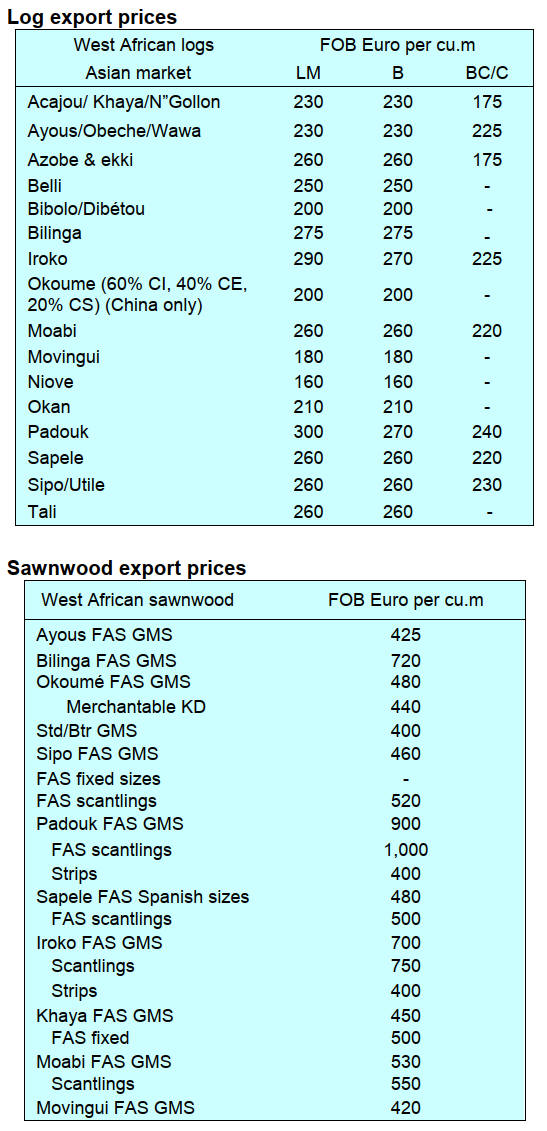
Through the eyes of industry
The latest GTI report lists the challenges identified by the private
sector in the Republic of Congo and Gabon.
See:
https://www.itto-ggsc.org/static/upload/file/20240223/1708653799120615.pdf
2.
GHANA
Industries lament introduction of new taxes
Industrial enterprises are complaining about the impact
numerous taxes are having on their businesses and called
on the government to reassess the tax regime. Pressure is
mounting on the newly appointed Minister of Finance, Dr.
Mohammed Amin-Adam, as industrialists demand the
removal of, what they describe as, ‘nuisance taxes’ from
the country’s tax regime.
The industry anticipates that the mid-year budget review,
expected to be laid before Parliament in the next few
months can create an opportunity to remove some taxes
such as the Electronic Levy (E-Levy) and the Emission tax
among others. The industry also mentioned the numerous
port charges which are also eating deeply into their
finances making it difficult to compete and fully benefit
from the African Continental Free Trade Area (AfCTA).
The Trades Union Congress (TUC) and other
organisations have urged the suspension of the new
Electricity and Emission taxes and some economists have
advised the government to reconsider the introduction of
the 15% VAT. They also said for businesses and
individuals, yet to recover from the economic challenges
in 2022 and 2023, the introduction of these new taxes
would further worsen their plight.
In a letter from the Ministry of Finance to the Ghana
Revenue Authourity (GRA) earlier this year the Ministry
explained that the new measures were part of the
government's medium-term revenue strategy and the
International Monetary Fund (IMF) supported post Covid-
19 programme for economic growth.
See:
https://citinewsroom.com/2023/04/tuc-fears-of-more-layoffs-tough-times-over-3-new-taxes/
Power tariffs for industry lowered
The Public Utilities Regulatory Commission (PURC) has
adopted adjustments to electricity tariffs aimed at
providing relief to companies and consumers declaring a
6.5% reduction in electricity tariffs for residential users
and a nearly 5% reduction in the industry tariff band.
See:
https://www.purc.com.gh/attachment/829688-20240228090210.pdf
MoU to promote industrialisation
The Association of Ghana Industries (AGI) and the Ghana
Commodity Exchange (GCX) have committed to
bolstering the industrial and agriculture sectors through a
strategic MoU. The Agreement is aimed at injecting
liquidity into commodity markets, strengthening price
discovery mechanisms and fostering a more robust trading
environment for designated products. The MoU also aims
to improve existing value chains by linking production to
high value markets.
See:https://gna.org.gh/2024/03/agi-ghana-commodity-exchange-sign-mou-to-support-agriculture-sector/
Protection of country’s forest mentioned in State of the
Nation Address
In his State of the Nation Address the President of Ghana,
H.E Nana Addo Dankwa Akufo-Addo, said government’s
strategic efforts over the years on forest sustainability led
to the recultivation of 690,000 hectares of degraded forest
between 2017 and 2022 under the Ghana Forest Plantation
Strategy.
In his Statement, the President emphasised that Ghana
would do everything possible to continue to work to
ensure the protection of the country’s forest and wildlife
resources.
In related news, the Ghana Forest Plantation Technical
Steering Committee (GFPTSC) has presented a revised
version of the Ghana Forest Plantation Strategy (GFPS) to
the Forestry Commission after an evaluation that was in
accordance with the Monitoring and Evaluation
Framework of the GFPS which prescribes periodic review
of the strategy document to ensure its alignment with
changing conditions and priorities.
See:
https://www.modernghana.com/news/1295633/42-million-trees-planted-over-the-past-three-years.html
and
https://fcghana.org/gfptsc-technical-steering-committee-submits-revised-gfps/.
Renewable energy use in schools
The Attorney-General and Minister of Justice, Godfred
Yeboah Dame, has advocated the promotion of renewable
energy use in schools. He said, this would ensure regular
supply of electricity and also avoid situations where the
power supply to some institutions was cut for non-
payment of electricity bills.
Mr. Dame pointed out that the UN Climate Change Action
Policy had estimated that the share of renewable and solar
energy use in the global power supply system would more
than triple by 2050. He called on educational institutions
to consider an energy mix for every senior high school.
See:
https://www.graphic.com.gh/news/general-news/ghana-news-attorney-general-advocates-renewable-energy-use-in-schools.html
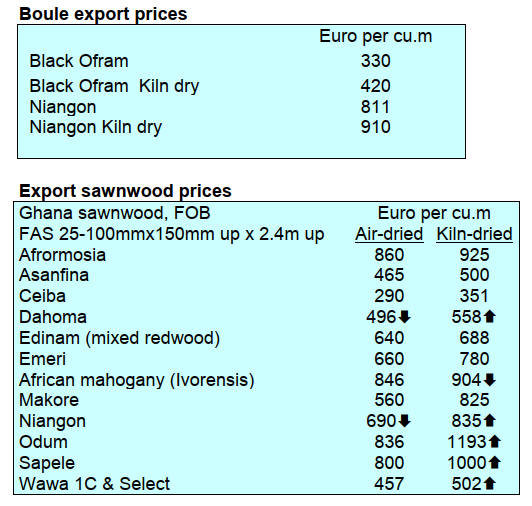 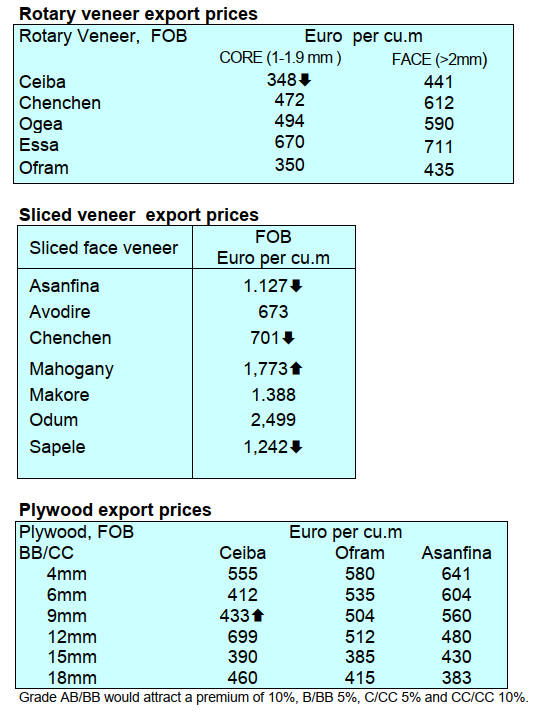
3. MALAYSIA
MIFF 2024
The wood products industry is expected to recover this
year following improved growth projections for the US
economy, the main market for Malaysia’s furniture
exports.
Johari Ghani, the Minister for Plantation and Commodities
said the industry’s performance has declined over the past
two years but the government is committed to supporting
its sustainability and growth. “For 2024, we are quite
confident that furniture exports will rebound to their
former strength,” he said after opening the Malaysia
International Furniture Fair (MIFF) 2024 held in Kuala
Lumpur.
In his address the Minister said the timber and furniture
industry was not insulated from the effects of global
headwinds which resulted in exports of wood products
falling by 13% in 2022 and 18% last year. This was
largely due to a weakening in housing demand in the US,
the biggest buyer of Malaysian furniture, accounting for
over half of furniture exports.
The Malaysian furniture industry is largely export-
oriented, with 44% of exports being shipped to 186
countries over the past five years. Johari said the
government has spent almost RM 1 billion for the Forest
Plantation Development Programme and provided soft
loans to 88 companies for replanting projects.
The Malaysian International Furniture Fair (MIFF), one of
the main furniture trade show in South-East Asia, had a
record number of 714 exhibitors from 15 countries. The
four-day event, from 1 - 4 March, was held in the
Malaysia International Trade and Exhibition Centre. The
Fair is expected to bring in US$1.3 bil. in sales.
See:
https://www.freemalaysiatoday.com/category/nation/2024/03/01/timber-industry-likely-to-recover-with-us-economy-rebound-says-johari/
International Conference in Sarawak
Sarawak Timber Association with partners WWF
Malaysia and the Sarawak Forestry Department organised
a conference entitled “Preserving Tropical Forests through
sustainable management”. The conference was supported
by ITTO.
See:
https://www.itto.int/news/2024/03/06/forestry_offers_pathway_for_sustainable_future_says_executive_director_at_conference/).
The following highlights two presentations:
Sarawak has reduced its timber harvesting operations to
approximately two million cubic metres per year to
balance the need for environmental conservation and
economic considerations, said Hamden Mohammad the
Sarawak Forest Department Director. He added that
requirements on forest management certification apply to
both natural and planted forests.
“We currently have 25 certified natural forests covering
over 2.2 million hectares as well as seven certified forest
plantations covering approximately 97,000 hectares” he
told participants at the opening ceremony of the
Conference.
He added “the Sarawak government strongly believes that
the economically viable, environmentally sound and
socially acceptable responsible forestry practices are
important to show the government’s commitment to
maintain and enhance the best management practices. He
pointed out that Sarawak’s forest policy has undergone
substantial reform with increased importance on
environmental protection and the sustainable management
of forest resources.
On a related subject, Hamden said Sarawak Forest
Departmrnt partnered with the Sarawak Timber
Association (STA) to develop seven handbooks on
Reduced Impact Logging (RIL) aimed at aiding ground
personnel in effectively implementing RIL practices. The
guidelines mark a significant stride towards standardising
timber harvesting practices and enhancing regulation
within Sarawak’s timber industry.
Meanwhile, the Sarawak Timber Association is appealing
to the authorities and policymakers to give full and
continuous support to timber industry players who have
made great sacrifices to ensure that their forest
management units are certified.
STA chairman, Henry Lau, said this can be accomplished
through the provision of transparent, consistent,
sustainable and stable longterm policies, particularly those
concerning government regulations and taxes, licensing as
well as a sustainable long-term tenure.
See:
http://theborneopost.pressreader.com/article/281496461243637
Sabah’s carbon trade deal challenged
The controversial Nature Conservation Agreement (NCA)
involving a two-million-hectare of State forest reserve for
carbon credit trading cannot move forward as it has been
deemed legally flawed.
The legal advisor to Sabah Government, Ahmad Fuad,
said the Agreement does not conform with the Sabah
Biodiversity Enactment 2000 which required all
exploitation of biological resources to be first approved by
the Director of the Biodiversity Institute and the
Biodiversity Council.
The Agreement, signed in 2021 with Singapore-based
Hoch Standard Pvt Limited, fails to take into account the
legal requirements that are needed to be obtained from the
two bodies that oversee all conservation and sustainable
use of natural capital, said Fuad.
Furthermore, he said, an approved "benefit sharing
agreement" with local people must be in place to guarantee
that the native communities benefit. It is claimed the
Agreement fails to provide guarantees to natives and
community rights.
See:
https://www.thestar.com.my/news/nation/2024/02/28/sabah039s-carbon-trade-deal-bogged-down-with-legal-flaws-says-lawyer
Ringgit recovers after steep decline
The Malaysian ringgit has recently drifted down to levels
against the US dollar not seen since the depths of the
Asian financial crisis around 25 years ago.
The ringgit hit a 26-year low of 4.8 to the dollar in late
February which prompted a Ministry of Finance official to
say Bank Negara Malaysia is prepared to defend the
ringgit. By mid-March the ringgit had recovered to 4.68
against the dollar.
4.
INDONESIA
Benchmark export prices (HPE) March 2024
The following is a list of Wood HPE for 1 -31 March
2024.
 
Processed Wood
Processed wood products which are leveled on all four
sides so that the surface becomes even and smooth with
the provisions of a cross-sectional area of 1000 mm2 to
4000 mm2 (ex 4407.11.00 to ex 4407.99.90)
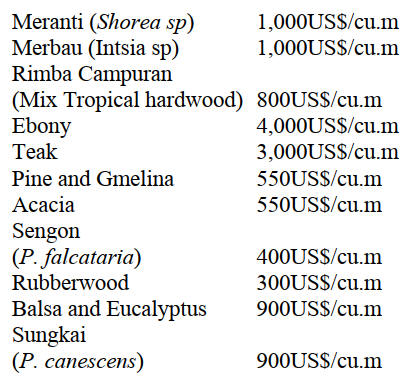
Processed wood products which are leveled on all four
sides so that the surface becomes even and smooth with
the provisions of a cross-sectional area of 4000 mm2 to
10000 mm2 (ex 4407.11.00 to ex 4407.99.90)

Processed wood products which are leveled on all
four
sides so that the surface becomes even and smooth with
the provisions of a cross-sectional area of 10,000 mm2 to
15,000 mm2 (ex 4407.11.00 to ex 4407.99.90)

See:https://jdih.kemendag.go.id/pdf/Regulasi/2024/198_Kepmendag%20HPE%20dan%20HR%20Produk%20Pertanian%20dan%20Kehutanan%20Maret%202024%20+%20Lampiran-.pdf
Ministry publishes EU market entry update
Didi Sumedi, Director General of National Export
Development introduced an update on "EU Market Entry
Requirements for Wood Sector" at an event attended by
more than 60 Indonesian timber businesses, business
associations and representatives from related
ministries/institutions.
Didi stressed the importance of staying updated on export
market regulations as they constantly change. He
emphasised all stakeholders must work together to
anticipate these changes to boost the export performance
of Indonesian wood products.
The event was a collaboration between the Directorate
General of National Export Development under the
Ministry of Trade and the Swiss Import Promotion
Programme (SIPPO).
The objective was to inform on the regulations governing
wood products in the European Union thereby promoting
the acceptance of Indonesian wood products. Over the past
five years SIPPO has worked with the Directorate General
of National Export Development to enhance the
capabilities of businesses in the Indonesian forest sector
through programmes, workshops and export market
promotion strategies.
See:
https://www.kemendag.go.id/berita/foto/kemendag-gelar-pembaruan-eu-market-entry-requirements-for-wood-sector
In related news, the HIMKI chairperson, Abdul Sobur,
said that the impact of the European Union Deforestation-
Free Regulation (EUDR) could reduce the value of
Indonesian furniture exports to the EU. He said that the
EUDR would pose a challenge to the entry of processed
wood products from Indonesia into the European market
due to strict raw material requirements. Europe, he said,
accounts for a large share of Indonesian furniture exports
at around 28%.
Sobur stated that the EUDR procedure, which involves
due diligence for product traceability, makes it challenging
for Indonesian furniture exporters to continue to ship to
the EU. He added “HIMKI has over 2,000 members but
not all can meet EUDR requirements”. He stressed that
HIMKI is assisting furniture entrepreneurs understand the
EU import regulations and urged the government to help
companies prepare for the impact of EUDR.
See:
https://mediaindonesia.com/ekonomi/656110/eudr-ancam-pukul-ekspor-mebel-dan-furnitur-ri-ke-eropa
Investors invited to revitalise wood processing
Indonesia is welcoming Chinese investors to support the
revitalisation of wood processing in the industry. Acting
Director General of Sustainable Forest Management at the
Ministry of Environment and Forestry, Agus Justianto,
stated that the revitalisation of industrial machinery will
added further value to forest products. This was
announced during an audience with the Indonesian
Furniture and Craft Industry Association (HIMKI) and the
China National Machinery Association (CNFMA) at the
Indonesia International Furniture Expo (IFEX) 2024.
According to data from the Ministry of Environment and
Forestry, sawmill and woodworking industries are
comprised of 3,485 units, including 391 large-scale units
(with a capacity of more than 6,000 cu.m/year) and 3,094
small and medium-scale units (with a capacity of less than
6,000 cu.m/year).
The total installed capacity of sawmill and woodworking
industries was said to be 9.5 million cu.m/year for large-
scale operations and 10.5 million cu.m/year for small and
medium-scale operations.
Agus mentioned that the industry’s capacity utilisation rate
is currently very low mainly due to the lingering effects of
the Covid-19 pandemic and aging machinery. According
to Agus, investor support, including that from China, is
crucial for revitalising wood processing by introducing the
latest technologies in processing. Further efforts are
needed to secure financial support for implementing of
machinery upgrading.
See:
https://agroindonesia.co.id/revitalisasi-mesin-industri-kayu-indonesia-undang-investor-china/
ASMINDO - Indonesia can be a hub for furniture
development
The chairman of the Indonesian Furniture Industry and
Handicraft Association (ASMINDO), Dedy Rochimat,
said Indonesia has the potential to become a global hub for
furniture development and production.
Indonesia boasts abundant natural resources, particularly
in terms of sustainable raw materials, a rich culture,
unique locally inspired furniture designs and is supported
by the world’s fourth-largest population. "This potential
needs to be developed in synergy with all domestic
stakeholders and through mutually beneficial international
collaboration", he said.
He added that Indonesia is the world’s largest producer of
rattan and ranks as one of the top three countries in
bamboo resources.” He emphasised the necessity of
promptly utilising and developing these potentials to
positively contribute to the furniture industry’s role in
generating foreign exchange and improving social welfare.
Rochimat said the demand for eco-friendly furniture is
estimated to have reached 8.6% of the overall market and
that demand for eco-friendly furniture presents a
significant opportunity that must be collectively addressed
by establishing research and production centres for eco-
friendly furniture.
In a bid to promote eco-friendly practices, Asian furniture
manufacturers have initiated efforts to encourage the
utilisation of bamboo as a substitute for plastic. This
initiative aligns with the increasing trend towards
environmentally friendly furniture products. The
utilisation of bamboo was among the key topics discussed
at the 25th Annual General Meeting of the Council of
Asian Furniture Associations (CAFA).
The meeting took place in Tangerang in February and was
attended by 32 delegations from CAFA member countries.
The Association of Indonesian Furniture and Handicraft
Industries (ASMINDO) hosted the meeting.
See:
https://katadata.co.id/berita/industri/65deb9b716ab5/asmindo-dorong-indonesia-jadi-pusat-pengembangan-furnitur-dunia
and
https://forestinsights.id/asian-furniture-manufacturers-launch-initiative-to-utilize-bamboo-as-substitute-for-plastic/
IFEX 2024 - record level of business transactions
Indonesian furniture and handicraft products are
increasingly in demand in the international market. These
products were introduced at the Indonesia International
Furniture Expo (IFEX). During the four day exhibition
direct transactions or on the spot sales were recorded at
US$300 million.
In this year's IFEX there were buyers from 117 countries
with most coming from Europe, Australia, China and the
United States, as well as from countries such as India,
Bahrain, Oman and the United Arab Emirates. The IFEX
Project Manager, Rizki Pahrudi, explained that the number
of international buyers at this years’ show was double that
during the previous show.
See:
https://www.liputan6.com/bisnis/read/5542275/pameran-furniture-ifex-2024-kantongi-transaksi-usd-300-juta
Indonesia should showcase GHG emissions reduction
effort - Minister
Environment and Forestry Minister, Siti Nurbaya,
underscored the need for Indonesia to continue to
demonstrate, at the global level, its significant
performance in reducing greenhouse gas (GHG) emissions
supported by international assistance.
The Minister revealed that Indonesia had received support
from various international communities to achieve climate
targets, including collaboration with Norway for funding
based on performance in lowering GHG emissions from
reducing deforestation and forest degradation.
The Minister remarked that the first funding from Norway
was used to support five activities in the forestry and other
land use sector (FOLU) namely sustainable forest
management, increasing carbon reserves, conservation,
peat and mangrove management and information
disemination. "
In a related development the Minister indicated that the
Ministry was considering schemes to involve business
actors in supporting funding for reducing greenhouse gas
emissions and achieving the country's climate targets.
She said "the carbon business is not just about carbon
trading but also about raising the reputation of a
company." She remarked that companies looking to
improve their reputation can be involved in the efforts to
reduce emissions with the results contributed as an effort
to achieve climate targets.
In a statement during the Workshop on ‘Result Based
Contribution of Indonesia's FOLU Net Sink 2030’ the
Minister reported that Indonesia's efforts to suppress the
amount of greenhouse gas emissions generated have
resulted in a decrease of 875.7 million tonnes of carbon
dioxide equivalent based on data in 2022 .
See:
https://en.antaranews.com/news/306690/indonesia-should-showcase-ghg-emissions-reduction-effort-minister
and
https://en.antaranews.com/news/306747/indonesia-considers-involvement-of-business-actors-in-climate-funding
and
https://en.antaranews.com/news/306723/indonesia-managed-to-reduce-8757-million-tons-of-co2e
Papuan indigenous people's role in forest preservation
The Ministry of Environment and Forestry (KLHK),
through the Papua Ecoregion Development Control Center
(P3E), commended the role of Papuan indigenous people
in preserving forests and the environment. The head of
P3E in the Ministry, Edward Sembiring, said “local
wisdom maintained by indigenous people has long been in
line with the principles of conservation”.
He added that indigenous communities have a crucial role
to play in protecting the environment and ecosystems from
excessive exploitation. He explained that the success of
the work plan to reduce greenhouse gas emissions by the
forestry sector through Indonesia's Forestry and Other
Land Use (FOLU) Net Sink 2030 Programme requires the
support of indigenous communities.
See:
https://en.antaranews.com/news/307905/klhk-lauds-papuan-indigenous-peoples-role-in-forest-preservation

Through the eyes of industry
The latest GTI report lists the challenges identified by the private
sector in Indonesia.
See:
https://www.itto-ggsc.org/static/upload/file/20240223/1708653799120615.pdf
5.
MYANMAR
Controversial timber trade persists despite sanctions
In November last year the European Union law
enforcement agency (Europol) seized a small cargo of
Myanmar timber that had been smuggled into the EU
which, the media says, highlights the persistent trade in
Myanmar timber despite the trade sanctions.
Italian government data analysed by Federlegno Arredo
and shared with an affiliate of the International
Consortium of Investigative Journalists (ICIJ) appears to
show, between January and October 2023, Italian
companies imported more Myanmar wood products than
any other European country.
The ICIJ reports an analysis of US customs data which
seems to show that US companies and individuals have
managed to import small volumes of Myanmar teak. In
response to reports of sanction busting imports the US
Justice Department announced the creation of an
interagency task force to strengthen efforts to combat the
illegal trade in timber.
According to the Myanmar Ministry of Commerce,
Myanmar exported US$235.6 million worth of timber
from October 2021 to mid-2023.
See:
https://www.icij.org/investigations/deforestation-inc/myanmars-controversial-timber-trade-persists-despite-western-sanctions/
and
https://www.icij.org/investigations/deforestation-inc/myanmar-teak-trade-sanctions-military-regime/
and
https://www.icij.org/investigations/deforestation-inc/new-justice-department-led-task-force-pledges-global-crackdown-on-illegal-timber-trade/
Military conscription activated
The Myanmar Government spokesman, Zaw Min Tun, has
said at least 13 million people will be liable to be
conscripted out of the country’s population of 55
million. He said the first intake will be in mid-April after
Myanmar's New Year holiday ‘Thingyan’.
In late February it appears a decision was taken to exclude
women from the military call-up. The media reports the
military aims to recruit 60,000 soldiers in a year. Evading
conscription will be punishable by up to five years in jail
and a fine.
In related news, Malaysia’s Deputy Foreign Minister,
Datuk Mohamad Alamin and Assistant Secretary-General
of the United Nations (UN) Khaled Khiari discussed
collaboration in peacekeeping operations in Myanmar.
Implementing the ASEAN Five-Point Consensus proposal
on Myanmar is facing serious challenge.
In other news, as a result of the military call-up in
Myanmar there is an exodus of young people from
Myanmar to Thailand. The Thai government, in
collaboration with NGOs and international partners, is
working to establish support systems for these refugees.
See: See:
https://www.reuters.com/world/asia-pacific/myanmar-juntas-conscription-plan-lays-bare-toll-fighting-rebels-2024-02-16/
and
https://www.bernama.com/en/world/news.php?id=2278300
6.
INDIA
Mandatory Quality Control
Order on wood panels
postponed
In a news flash Plyreporter says the Quality Control Order
(QCO) for mandatory Bureau of Indian Standards (BIS)
on MDF, particleboard and blockboard has been
postponed for a year. The new date of implementation is
11 February 2025 according to a Ministry of Commerce
notification dated 12 March. The wood based panel QCO
will be effective for small and micro industries from 11
May 2025 and 11 August 2025 respectively.
See:
https://www.plyreporter.com/article/153814/implementation-of-mandatory-qco-on-plywood-shuttering-ply-wooden-doors-postponed
Indiawood 2024 participants see bright prospects in
India
Indiawood 2024, the woodworking machinery show, was
held in February in Bengaluru and the ITTO
correspondent attended and participated in the Global
Summit. He reported there were many foreign exhibitors
as well as domestic companies participating in the show
and “overall the vibe from participants was positive”.
He commented, “one thing that is on everyone’s mind was
that next 10 years is set to be a boom time for the Indian
economy and there will be major investment in
infrastructure and in the manufacturing sector.
However, concerns were raised by local manufacturers
who depend on imported raw materials such as decorative
plywood and laminated boards imports of which are going
to face severe issues in meeting the new Standards”.
Focus on capital spending in recent budgets
The Indian economy performed well during 2023 and the
National Statistical Office has estimated that GDP would
be 7.3% during fiscal 2023–24. This is higher than the
IMF’s December 2023 projected growth of 6.3%.
To drive growth the government has focused on capital
spending in recent budgets and supported State
governments to do the same. However, Biswajit Dharfrom
the Council for Social Development suggests the private
sector’s response to the government’s investment push has
less than anticipated. Dharfrom says private investment
has been declining and foreign investors reduced their
participation in India.
The tepid response from private investors is concerning as
the government will be unable to sustain high levels of
capital spending while also addressing development
deficits through spending on social sectors and welfare
schemes, says Dharfrom.
GDP estimates show one area of weakness — the
relatively slow growth of agriculture and allied sectors.
These sectors grew by less than 2% in the 2022–23 which
is half of their growth in the previous fiscal year.
Uncertain weather conditions, including uneven
distribution of rainfall, adversely affected the performance
of these sectors.
The National Statistics Office predicted that the
manufacturing sector will expand by 6.5% in 2023–24,
considerably higher than the 1.3% growth in the previous
financial year. It is reported that output in the labour-
intensive industries has declined.
See:
https://eastasiaforum.org/2024/03/02/indias-gdp-growth-masks-economic-challenges/
Market-based mechanism under the Green Credit
Programme
The Green Credit Rules 2023 were notified in October last
year with the objective of creating a market-based
mechanism under the Green Credit Programme (GCP).
Directive on land for tree planations raises concerns
In early March the central government released a directive
for tree planations under the the Green Credit Programme
(GCP). The guidelines require Forest Departments to
identify degraded land including open forests and scrub
land, wasteland and catchment areas under their
administrative control and make these available for tree
planations. Critics of this initiative fear that the directive
appears to bring all forests and forest-like areas available
for the GCP and that the clearing for plantations would
lead to a loss of biodiversity.
See:
https://timesofindia.indiatimes.com/home/sunday-times/all-that-matters/indias-green-credit-rules-might-end-up-creating-green-deserts/articleshow/108168308.cms
and
https://www.eco-business.com/news/india-bets-on-green-credits-but-could-they-reward-deforestation/
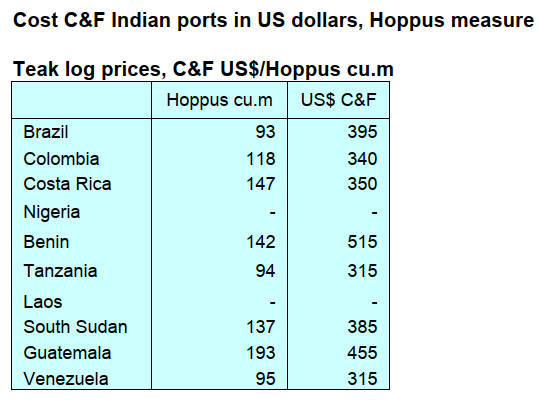
 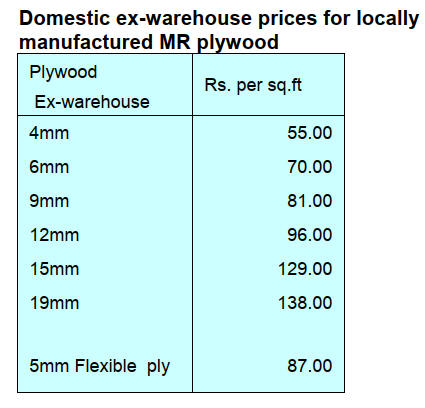
7.
VIETNAM
Wood and Wood Product (W&WP) trade highlights
According to Vietnam’s Office of Statistics
W&WP exports to the Japanese market in
February 2024 amounted to US$110 million,
down 33% compared to January 2024 and down
23% compared to February 2023. In the first 2
months of 2024 W&WP exports to Japan earned
US$273 million, up almost 1% over the same
period in 2023.
Vietnam’s W&WP exports to Holland in
February 2024 reached US$15 million lifting the
exports in the first 2 months of 2024 to US$32.6
million, up 120% over the same period in 2023.
Vietnam’s exports of bed and dining room
furniture in February 2024 soared to US$210
million, up 62% compared to February 2023. In
the first 2 months of 2024 exports of these two
categories of furniture earned US$474, up 90%
over the same period in 2023.
Vietnam's office furniture exports in February
2024 brought in about US$24 million, up 18%
compared to February 2023. In the first 2 months
of 2024 office furniture exports totalled US$53
million, up 35% over the same period in 2023.
Vietnam's ash imports in February 2024 were
21,700 cu.m worth US$5.8 million, down 42% in
volume and 41% in value compared to January
2024. However, compared to February 2023 there
was a decrease of 29% in volume and 27% in
value. In the first 2 months of 2024, ash imports
reached at 73,900 cu.m, worth US$19.5 million,
up 32% in volume and 34% in value over the
same period in 2023.
Log and sawnwood imports from the EU to
Vietnam in January 2024 stood at 50,360 cu.m, at
a value of US$15.41 million, down 7.5% in
volume and 12% in value compared to December
2023 but up 38% in volume and 44% in value
compared to January 2023.
Pine imports to Vietnam in February 2024
amounted to 35,200 cu.m, worth US$8.1 million,
down 39% in volume and 39% in value compared
to January 2024. However, compared to February
2023, pine wood imports increased by 16% in
volume and 24% in value. In the first 2 months of
2024 pine wood imports were 115,400 cu.m
worth US$26.4 million, up 92% in volume and
103% in value over the same period in 2023.
Vietnam’s NTFP exports in February 2024 were
valued at US$75 million, down 6% compared to
January 2024, but up 32% over the same period
in 2023. In the first 2 months of 2024,NTFP
exports totalled US$154.75 million, up 51% over
the same period in 2023.
Exports recovering but bottlenecks remain
According to data from the Department of Forestry
(Ministry of Agriculture and Rural Development) in the
first 2 months of 2024, the export value of wood and forest
products is estimated to have reached US$2,68 billion, an
increase of 47% over the same period last year.
The value of imports of wood and wood products in the
first 2 months of this year is estimated at US$355 million,
up 31% over the same period in 2023. The wood product
trade surplus in the first 2 months of the year is estimated
at US$2,465 billion.
Despite the positive trend in exports the timber industry is
facing many challenges. Trieu Van Luc, Deputy Director
of the Forestry Department said the impact of the conflict
between Russia - Ukraine and between Israel and Hamas
and shipping problems in the Red Sea is complex and
unpredictable. In addition, global shows signs of slowing
and consumers continue to tighten spending on non-
essential products including furniture and wood products.
Adding to the challenges of the timber industries is the
need to address the requirements in importing countries to
ensure legality and ensure no forest degradation or
deforestation.
A representative of the timber industry shared experiences
on the difficulties and obstacles in importing wood raw
material, processing and exporting wood products. Do
Xuan Lap, Chairman of Vietnam Wood and Forest
Products Association, said that in the US regulations on
the origin of wood raw material are strict.He said he was
aware the US Department of Commerce is amending a
number of regulations on anti-dumping and anti-subsidy
investigations including ways to identify previously
unrecorded subsidies such as export insurance, debt
cancellation and tax advantages.
For the EU market, the EUDR will come into force this
year said Do Xuan Lap and action is needed as Vietnam's
regulations on determining the origin of wood are
currently not specific. Another issue for the Vietnamese
timber exporters is the descision by India to apply new
Standards and there is insufficient time for manufacturers
to comply.
Integration is a must
In 2024 the timber industry aims for US$15.2 billion in
exports of wood and forest products of which wood
product exports are set to be at US$14.2 billion, an
increase of about 6% compared to 2023. Nguyen Tuan
Thanh, Vice Chairman of Binh Dinh Provincial People's
Committee said that to achieve the set goals the wood
industry still has a lot of work to do. Currently, production
costs are still quite high and there are risks in forest
certification as well as traceability. A solution to raw
material supply needs to be found.
On the business side it is necessary to focus on improving
quality, investing in machinery and equipment and
meeting sustainability requirements. Only then will goods
be welcomed by customers in export markets.
Acknowledging the opinions of authorities, associations
and businesses the Deputy Minister of Agriculture and
Rural Development, Nguyen Quoc Tri, further commented
that the wood industry currently faces many difficulties
and to solve these issues he requested that wood industry
associations and businesses agree on the view that to
improve product value supply chains must be fully
integrated.
He added that, currently, wood processing enterprises do
not have to measure carbon emissions but it is likely they
will be required to do so soon. He asked how to reduce
emissions and bring the highest value? To achieve this he
said enterprises need to proactively link with forest
growers and to integrate. At the same time, businesses
need to promptly provide information about regulations
and share skills to avoid risks.
He emphasized “it is desirable that processing enterprises
promote links with forest growers and forest owners to
develop large timber forests. This not only benefits forest
growers but businesses can also proactively source raw
materials that are legal, certified, and originating."
Nguyen Quoc Tri acknowledged that there are very few
direct exports as most go through intermediaries and as
such the full value is not captued. He urged associations
and businesses to get together to discuss this and find a
solution.
See:
https://www.vietnam.vn/en/nganh-go-hop-ban-thao-go-kho-khan-thuc-day-xuat-khau-nam-2024/
HawaExpo 2024
The 2024 Ho Chi Minh Export Furniture Fair (HawaExpo
2024) opened in HCM City in March with the aim of
highlighting the strengths of Vietnam’s wood and
handicrafts industry to international customers.
For the first time the annual Expo has a “Create Hall”
dedicated to design and creativity in the furniture industry.
Vietnamese businesses accounted for 80% of participants
along with prominent Southeast Asian handicraft brands,
furniture design and innovative technology-based
companies, suppliers and service providers.
The Fair included B2B matching, seminars, factory visits
and other activities. Speaking at the opening ceremony,
Deputy Minister of Industry and Trade Phan Thị Thắng,
said the wood industry has always been one of the
country’s pivotal economic sectors.
“Enterprises in the industry have focused on enhancing
product quality and strengthening brand value to gain a
firm foothold in large markets such as China, the US,
Europe and Japan and expand the presence of the
Vietnamese wood and forest products to 160 countries and
territories.”
Exports of wood and timber products declined for the first
time ever in 2023 but there were positive signs in January
this year with exports topping US$1.49 billion, a sharp
increase year-on-year, Thắng said.
During the opening Nguyễn Quốc Trị said, “to achieve the
export target of US $15 billion this year, a year-on year
increase of 6%, the forestry sector needs to continue its
efforts and implement fundamental solutions in technical
innovation, raw material sourcing and utilisation and
product distribution.
Nguyễn Quốc Khanh, chairman of the Handicraft and
Wood Industry Association of HCM City (HAWA) and
also the Viforest Fair Co., Ltd, set up by five wood
processing industry associations (VIFOREST, HAWA,
BIFA, DOWA, and FPA), the Fair organiser said there
were three missions for the fair from the outset.
“Firstly, the fair prioritises trade promotion and showcases
the wood and handicraft products of Vietnam. Secondly, it
contributes to the industry’s transition from OEM
production to developing uniquely designed products
(ODM) to enhance the value of ‘Made in Vietnam’
products.
“And finally, the relentless innovation and creativity drive
by the HawaExpo to pioneer a professional, modern and
efficient trading event, affirming the true strength and
potential of Vietnam’s wood and handicrafts industry.”
Vietnam and US cooperation in combating illegal
timber trade
Training has started as the work to establish a mechanism
to identify and monitor the origin of wood and expand
export markets. Vietnam has proactively implemented a
host of measures to counter illegal timber trafficking over
the past two years under an agreement with the US on
fostering a more collaborative approach to combatting the
illegal timber trade according to Director of the Forest
Protection Department, Bui Chinh Nghia.
Addressing a training workshop in Hanoi for Vietnamese
government officials on countering illegal timber
trafficking, Mr. Nghia said Vietnam has reviewed
financial incentives for the wood processing sector,
enhanced customs supervision and inspection over
imported timber and boosted cooperation with countries
exporting wood materials to have control on the origin of
wood raw materials.
Various workshops have been arranged and co-organised
by attorneys from the Environment and Natural Resources
Division of the US Department of Justice and the Forest
Protection Department of Vietnam. A March technical
workshop was the first in a series of workshops and
discussions with Vietnam’s forestry, industry and non-
governmental stakeholders held under the US-Vietnam
Agreement to foster a more collaborative approach to
combatting the illegal timber trade.
The agreement with the US was signed in October 2021
with the aim of strengthening control over the origin of
wood products and wood supply chains, expanding export
markets, improving forest management mechanisms and
dealing with illegal wood exploitation and trade.
See:
https://vneconomy.vn/vietnam-us-strengthen-cooperation-in-combating-illegal-timber-trade.htm
8. BRAZIL
New bulletin - Brazilian
forests in 2023
The Brazilian Forest Service (SFB) together with SNIF
(National Forest Information System) has published a
bulletin with data on Brazilian forests in 2023. The topics
covered include secondary forests in natural forest areas,
botanical association in the National Forest Inventory and
forest certification in Brazil's forests.
The first topic deals with the methodology for calculating
and defining forest cover gains using the SFB database
and secondary forests monitoring data made available by
INPE (National Institute for Space Research) in the
TerraClass project. The second topic provides a step-by-
step report of the field survey on analysis and
consolidation of species data. The last topic provides
information on the importance of forest certification in
sustainable management practices.
Brazil, it is claimed, has the greatest biodiversity in the
world (more than 116,000 animal species and more than
46,000 plant species).
As such, the identification of species inventoried in the
field is fundamental to obtaining information on forest
biodiversity to contribute to establishing an efficient and
consistent method on the state and trends of forest
biodiversity on a large scale and the respective habitat
conditions.
The data collected in the latest survey allows for the
analysis, development and use of trend models to identify
the distribution of species and endemism allowing
conservation and management activities to be guided, as
well as responding to international conventions and
commitments.
The survey points to a downward trend in the area of
forests being certified worldwide from 2022 onwards but
in Brazil there no clear trend.
See:
https://www.yumpu.com/pt/document/read/68621636/florestal-259web
;https://snif.florestal.gov.br/images/pdf/publicacoes/Boletim_SNIF_2023.pdf
Evaluation of plywood, sawnwood and moulding
markets
In February this year the Brazilian Association of the
Mechanically Processed Timber Industry (ABIMCI) met
with representatives of the plywood, sawnwood and
mouldings committee to assess current demand in both
domestic and foreign markets and to identify the main
competing countries.
The companies representing the plywood sector also
assessed issues related to stocks in destination countries,
the volume of current production, costs and supply. A
broader analysis of logistical and port issues found that in
January 2024 dispatches were disrupted with numerous
changes to orders which hampered the flow of Brazilian
plywood exports. Logistical problems are also affecting
shipments of sawnwood to Asia, the United States and
Mexico which together account for more than half of
sawnwood exports.
Regarding the mouldings market, a broader and more
detailed assessment was made of the behavior and
dynamics of production by Brazil's main competitor
countries such as Chile, China and the countries of
Southeast Asia along with North American which is a
significant market for mouldings.
See:
https://abilink.abimci.com.br/ev/PRVu6/BM6/ef02/w8KE9Kx7yk/BQyw/
ABIMCI discusses expanding exports of wood
products
ABIMCI and FIEP (Federation of Industries of the State of
Paraná) met with the European Union's Ambassador to
Brazil in February 2024. ABIMCI stressed the good
practices already in place in Brazil's timber and forestry
sector emphasising that millers and manufacturers comply
with environmental standards and regulations required in
importing countries.
Also in February ABIMCI took part in a meeting with the
Mexican association CANAINMA (National Chamber of
the Timber Industry) seeking to bring the organisations
closer together to discuss a possible trade mission for
companies from Mexico to Brazil.
The possibility of holding business rounds between the
two countries was the main topic of the meeting as Mexico
continues to be one of the main importers of wood
products from Brazil. The possible development of a
cooperation agreement between the two organisations was
also part of the meeting's agenda and objectives.
See:
https://abilink.abimci.com.br/ev/PRVu6/BM6/ef02/w8KE9Kx7yk/BQyw/
Mato Grosso forest product traceability
The state of Mato Grosso exports forest products to 61
countries in America, Africa, Asia, Europe and Oceania.
The tropical timber shipped is sourced from sustainably
managed forests and the raw material supply chain is
transparent and traceable.
International buyers of wood products from 46 tree
species
identified and authorised in the State by environmental
agencies generated US$120 million in 2023 according to
foreign trade statistics. The main markets were the United
States (US$19.4 million), India (US$17.8 million), France
(US$13.6 million) and China (US$ 8.6 million).
In January 2024 the international trade in wood products
from natural forest species was worth around US$6
million (India US$1.6 million), China (US$478,000), the
United States (US$1.6 million) and France (US$ 934,200).
CIPEM (Center for Timber Producing and Exporting
Industries of Mato Grosso State) emphasised the
importance of the two main importing countries in Asia. It
also cited the importance of expanding the market for
Brazilain wood products by participation in the Global
Forum on Legal and Sustainable Timber (GLSTF) in
Macau, China which was attended by around 700
stakeholders from the forestry sector in 37 countries.
In the context of Brazilian exporting States, Mato Grosso
ranks 4th. It accounts for 2.3% of Brazil's international
timber sales. In 2023 Mato Grosso's timber industry
shipped around 190,600 tonnes of sawnwood and profiled
timber attesting to the quality of tropical timber from
managed areas.
The annual production capacity of the forest sector in the
State of Mato Grosso is around 7 million cu.m of tropical
timber coming from a total area of 4.7 million hectares
with the capacity to reach 6 million ha. of sustainably
managed forest.
Forest-based activities contribute to sustainable
development through conserving native vegetation,
promoting carbon capture and mitigating the effects of
climate change. In addition, this economic segment
generates direct and indirect jobs, ranking 4th in job
creation among the State's manufacturing industries.
See:
https://cipem.org.br/noticias/mato-grosso-exporta-produtos-florestais-com-rastreabilidade-para-61-paises-em-5-continentes
Through the eyes of industry
The latest GTI report lists the challenges identified by the private
sector in Brazil.
See:
https://www.itto-ggsc.org/static/upload/file/20240223/1708653799120615.pdf

9. PERU
Shipments of veneers
rose in 2023
As reported by the Services Management and Extractive
Industries of the Association of Exporters (ADEX),
exports of veneers and sheets of wood in 2023 were
valued at US$1.6 million, an increase of around 10%
compared to 2022 (US$1.48 million).
Mexico was the main destination accounting for US$1.14
million of the total followed by Ecuador (US$0.28
million) and the Dominican Republic (US$0.21 million)
and there was a year on year increase in the value at plus
76% for Ecuador and 10% for the Dominican Republic. In
addition, small quantities were shipped to Chile but there
were no exports to Australia and the United States as in
previous years.
According to the ADEX Commercial Trade Intelligence
System, 2023 was the third consecutive year of growth in
exports of veneers after the 19% decline in 2020 due to the
effects of the Covid-19 pandemic.
The main items exported were ‘Other veneers or plywood’
(US$1.16 million) including cedar plywood, screwwood
(tornillo, Cedrelinga cateniformis) veneer, ishpingo
plywood, ishpingo veneer and cumala (virola) plywood.
Other shipments (US$0.47 million) included decorative
sheets, ishpingo veneer for the furniture industry, joined
sheets.
Most of the products (US$1 .56 million) were shipped out
from Lima with the balance by land via Junín and Tumbes.
Veneer exports were ranked in eighth place in the ranking
of wood products surpassing only fibreboard and
particleboard.
Earnings from veneer shipments were far below that of
sawn wood (US$42.34 million), semi-manufactured
products (US$34.77 million), construction products
(US$5.55 million), fuelwood and charcoal (US$5.36
million), manufactured goods (US$4.32 million) and
furniture and parts (US$4.11 million).
Women contribute to the country's forestry and wildlife
management
The Forestry and Wildlife Resources Supervision Agency
(OSINFOR) says the forestry sector faces many challenges
but also significant opportunities. “As a woman at the
head of OSINFOR, an entity committed to supervising the
sustainable use of forest and wildlife resources, I consider
it essential to highlight the invaluable contribution of
women in the management and conservation of forest
resources”, said Lucetty Ullilen the Head of OSINFOR.
Ullilen indicated that women's participation not only
enriches the diversity of perspectives in the sector but also
strengthens the collective capacity to efficiently execute
public policies and promote sustainable practices.
“On Women's Day, we celebrate the essential role women
play in building a more sustainable and equitable future
for our communities, forests and people in general
considering current and future generations”, she said.
See:
https://www.gob.pe/institucion/osinfor/noticias/917210-con-fuerza-al-bosque-las-mujeres-contribuyen-en-la-gestion-forestal-y-de-fauna-silvestre-del-pais
APEC 2024 - SERFOR participation
The National Forestry and Wildlife Service (SERFOR)
together with representatives from the Ministry of Foreign
Affairs led Peru's participation at the 25th Meeting of the
APEC Group of Experts on Illegal Logging and
Associated Trade (EGILAT) that took place on February
in Lima as part of the Asia-Pacific Economic Cooperation
Forum (APEC).
Representing Peru, the Executive Director of SERFOR,
Alberto Gonzales Zuñiga, welcomed the experts and
highlighted that the 21 APEC economies have a total of
2,190 million hectares of forests which represents more
than half of the world's forest area and account for a major
share of exports of tropical wood and forest products.
The Head of SERFOR indicated that hosting APEC for the
third time is a great honour for Peru and for the forestry
sector it is very important because it is an opportunity to
highlight the progress made in the management of Peru’s
and forests in APEC countries such as the use of
technology to monitor and trace wood from its origin to
the market.
See:
https://www.gob.pe/institucion/serfor/noticias/913624-apec-2024-serfor-participa-en-grupo-de-expertos-de-21-economias-para-promover-productos-forestales-de-origen-legal
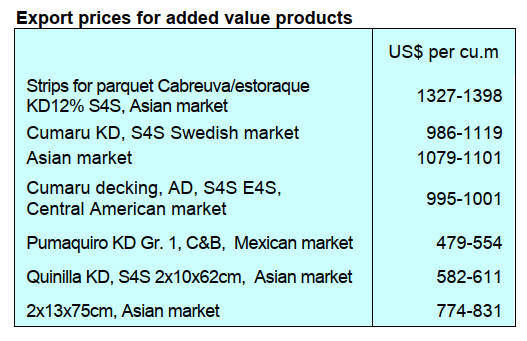
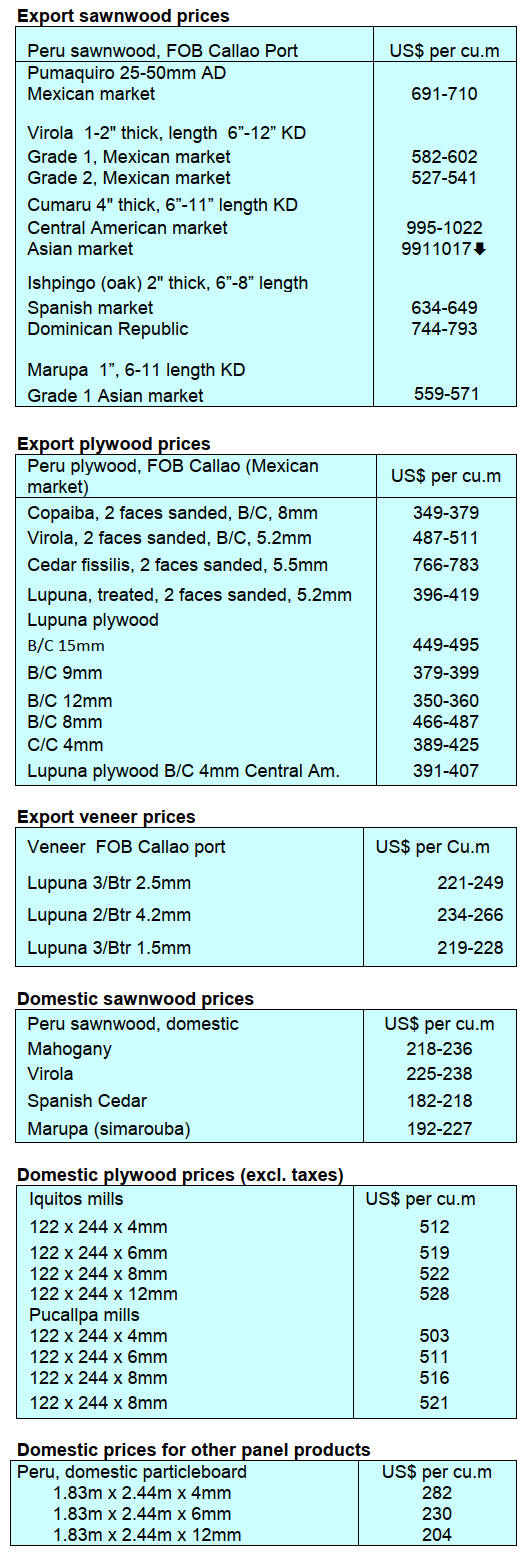
|